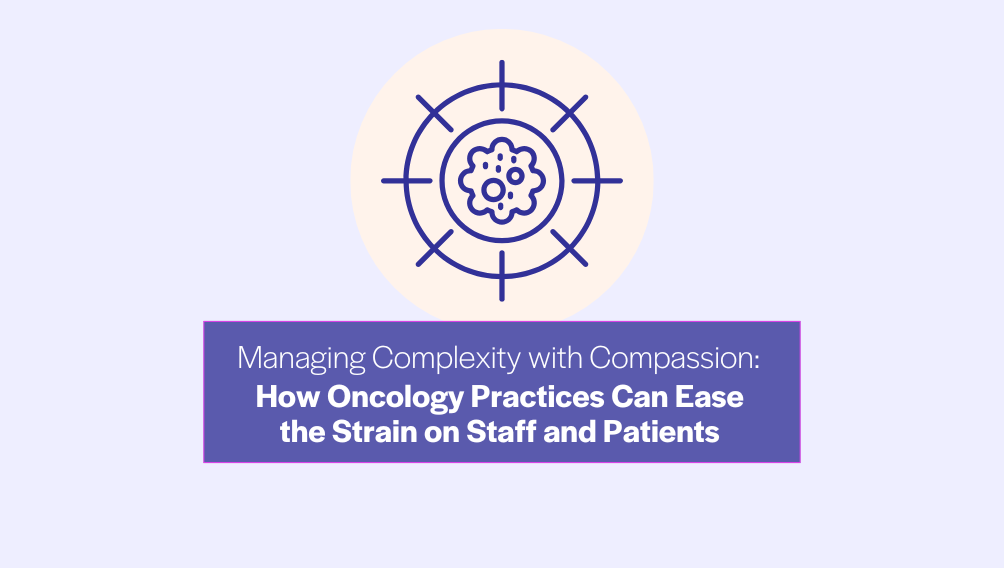Managing Complexity with Compassion: How Oncology Practices Can Ease the Strain on Staff and Patients

For oncology practices, each day is a balancing act of delivering coordinated, compassionate care to patients navigating serious and often complex conditions, while also managing a complex web of administrative responsibilities behind the scenes.
From chasing prior authorizations for chemotherapy to coordinating infusion chairs, labs, scans, and specialists visits across multiple locations, it’s no surprise that oncology administrators are overwhelmed. As one practice leader put it, “Scheduling is a constant puzzle”
The complexity adds up. Staff burnout rises. Referral or authorization delays lead to treatment delays. No shows become more frequent, especially when patients are feeling unwell or unclear on pre-visit instructions.
Amid all of this, the stakes couldn’t be higher.
When complexity slows care, everyone feels it
Unlike other specialties, delays in oncology aren’t just frustrating, they can be dangerous. A missed infusion or delayed scan can ripple through an entire care plan. Meanwhile, patients often need more support, not less, to stay on track during treatment.
The good news? Oncology practices are finding ways to ease the burden on staff and patients alike, without sacrificing the quality or humanity of care.
Reimagining the patient journey
Imagine this: A patient undergoing treatment receives a friendly reminder about their upcoming appointment, along with tailored prep instructions based on their specific visit type. If they’re feeling unwell, they can quickly reschedule with a few taps, rather than missing the visit entirely.
Behind the scenes, referrals, lab orders, and imaging requests flow seamlessly between providers and departments. Staff are no longer stuck on the phone coordinating next steps—they’re focused on higher-value work. And pre-authorizations for infusions or specialty meds move faster because everything is tracked and organized in one place.
The payoff? More patients complete their treatment plans on time. Fewer cancellations. Less chaos for staff.
Small Changes, Big Results
This isn’t just theoretical. Technology is playing a critical role in how oncology practices are delivering care and supporting their teams. Platforms like Luma Health are helping practices streamline operations, enhance patient engagement, and reduce the daily friction that weighs down both staff and patients.
At Monterey Bay GI Consultants, automation helps the specialty practice reduce the time and cost of outreach, saving $5.7 million in external call center expenses while driving $412,000 in increased referral volume. While not an oncology practice, their story shows how operational efficiency directly benefits both patients and practice revenue.
Banner Health saw similar results with a 20% reduction in no-shows for CTs, mammograms, and MRIs and a corresponding revenue boost. The key in both cases was consistent, personalized communication with patients—at scale.
For oncology, where communication needs to be not just timely but deeply compassionate, that kind of scalable personalization can be a game-changer.
Bringing Consistency to Complexity
One of the biggest challenges in oncology is variability: different sites, different teams, different instructions. But patients don’t see departments—they see one care experience. When intake instructions vary between locations, or when follow-up communications fall through the cracks, trust erodes.
Platforms like Luma help standardize workflows so every patient gets clear, accurate information, no matter where they’re seen. Automated care pathways and templates ensure consistency while still allowing for the empathy and human touch that oncology care demands.
And for patients moving through long and complex treatment plans, visibility matters. Practices can track where each patient is in their journey and ensure they’re ready for the next step, whether it’s an infusion, a scan, or a follow-up.
By automating the routine—like appointment reminders, pre-visit instructions, and follow-ups—oncology teams can focus on what matters most: delivering excellent care, with compassion and clarity.
Practical Steps to Enhance Your Oncology Practice
Improving oncology operations doesn’t have to start with a full-scale transformation. Here are three actions practices can take today to begin easing operational strain and enhancing patient experience:
- Audit your communication touchpoints. Where are patients getting confused or falling through the cracks? Map the journey from referral to treatment and identify opportunities to clarify, automate, or standardize.
- Start small with automation. Pick one workflow to automate—like referral outreach or lab coordination—and measure the impact. Even a single change can reduce hours of manual work.
- Give patients an easier way to engage. Whether it’s through two-way text messaging, mobile intake forms, or digital prep instructions, offering modern, convenient tools can dramatically reduce no-shows and improve satisfaction.
By taking these steps, oncology practices can enhance patient care, reduce staff burden, and improve overall operational efficiency.
Cancer care will always be complex. But by combining compassionate care with the right tools, practices can create a more supportive, efficient environment for everyone involved.
And that’s a win worth showing up for.
Want to see how your oncology practice could benefit from smarter workflows and more connected patient experiences?
Schedule a personalized demo with the Luma Health team to explore how our platform can help you streamline operations, reduce no-shows, and support your patients every step of the way.